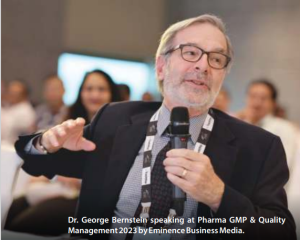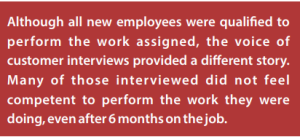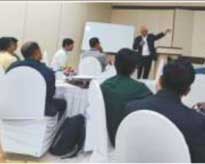
Why training is important
There are 2 reasons why training is important. The first is a GMP regulatory requirement [21CFR Part 211.25] “Personnel qualifications.” The second is a combination of 3 factors – the cost of materials, the cost associated with investigating mistakes, and the quality and safety of the drug products manufactured.
Not sure where I heard this, but the costs associated with an investigation on average are USD 10,000 in the States. This includes costs associated with the investigation, as well as delays on supply chain and order fulfillment, as well as product write-off or remanufacture.
Dr. George Bernstein is Managing Principal of Double Dragon Consulting, Inc., a consulting firm with a network of Subject Matter Experts (SMEs) located in the US, Europe, and Asia Pacific (China, Thailand, India). Dr. Bernstein has a Ph.D. in Chemical Engineering and over 30 years of experience in pharmaceutical manufacturing, laboratory operations, data integrity, effective training, and quality risk management. Since 1988, Dr. Bernstein has consulted both nationally and internationally with major pharmaceutical companies to address compliance actions by Health Authorities. He has lectured internationally on quality systems and root cause analysis to industry trade groups, quality organizations, and at PDA and Interphex conferences.
 Dr. Bernstein’s experience, insights, and innovative problem solving have been integral to his work which ranges from training effectiveness, GMP compliance, facility design, construction, and commissioning to business process re-engineering and process optimization. He has developed global quality standards (GLP, GCP, GPP) for a major international pharmaceutical company, and has assisted many clients with audit preparation, remediation activities, and communications with the US FDA.
Dr. Bernstein’s experience, insights, and innovative problem solving have been integral to his work which ranges from training effectiveness, GMP compliance, facility design, construction, and commissioning to business process re-engineering and process optimization. He has developed global quality standards (GLP, GCP, GPP) for a major international pharmaceutical company, and has assisted many clients with audit preparation, remediation activities, and communications with the US FDA.
He recently authored the following articles on LinkedIn: “FDA and Data Integrity – 3 Perspectives”; “API Manufacturing and Data Integrity – an Auditor’s Perspective”; “So, You Want to be a Consultant? Really?”; and “Training Compliance vs. Training Effectiveness.”
Impacts of training
A typical root cause for many deviations is “human error,” and the corrective action is often “retraining.” While this may be an expedient means to close an investigation, retraining does not always prevent human errors from recurring. In many cases, human error is not the most likely root cause, and as such, retraining is unlikely to be a robust fix. In some cases, you may want to consider inadequate procedure or inadequate supervision as a more appropriate root cause.
Many of the pharmaceutical companies I have consulted with cite staff turnover as a problem. They are reluctant to invest sufficient time and effort into training new employees out of concern that once trained, they will simply move to another employer, without a return on the training investment. The option to minimize training is not the best choice, however.
One client was concerned about the number of QC analyst errors. Analysts, who by all documentation were deemed qualified, confided to me that they were anything but confident doing what they were qualified to do. The high turnover resulted in many open positions, many inexperienced analysts, and little time for the experienced analysts to provide adequate training. Thus, a cycle was created that resulted in poorly trained analysts, contributing to the high turnover with the number of analyst errors a fertile ground for citations by a Health Authority inspector. Add this to the cost of investigations, resulting production delays, and re-testing.
Effective training methods
The first job that I had when I graduated from University was to teach 9th grade General Science. In the States, 9th graders are 13-14 years old. Anyone who’s had children knows that this can be a difficult age for them, their parents, and certainly their teachers. Unfortunately, I was not up for that challenge, and moved onto other work, but learned a lot about teaching, and more importantly, about learning.
I had to have teacher certification to be able to teach public school. This required that I take college-level courses on how to teach and how students learn. This was followed by a semester as a student-teacher, where I was paired up with an experienced teacher whose responsibility was to mentor me.
I moved on from teaching to other jobs during my career, and along the way obtained a PhD in Chemical Engineering. However, three things about how people learn, from my short stint as a classroom teacher, stuck with me. These are:
We all have different ways in which we learn. Some people are strong visual learners (think YouTube how-to videos), others are very hands-on learners. Few find listening to a lecture alone to be an effective way to learn.
Here’s an example:
Several years ago, I was consulting with a pharmaceutical company that had gotten into trouble with the US FDA. The stability of one of their terminally sterilized injection drug products had gone from 2 years to 9 months. Observation of the product formation process led us to suspect that a pH adjustment step might be the issue, due to inconsistency in how pH was measured from operator to operator.
I gathered together the following group to better understand where the issue was:
• Shop floor production operator
• Shop floor supervisor
• Chemist who provided training to production staff on how to perform pH measurements
• Head of HR / Head of Training.
I asked the production operator to describe the technique he followed when collecting and analyzing samples for pH determination. Part way through his explanation, the chemist burst out with “No – that’s not how I trained you!”
The shop floor supervisor responded with “That’s exactly how it’s written in the SOP.”
I asked the chemist how she conducted the training – was it hands-on or a lecture? Her response was that it was a lecture. I followed with another question – did she go on the shop floor to observe how the trainees were applying what they’d learned? Her answer was “no.”
At that point, the head of HR thanked everyone and said that the issue was clear – a lecture on how to perform a less than straight-forward pH measurement was clearly not effective; nor was the SOP that described the process clear.
Could training have been provided in a more effective manner?
Yes, if:
1. Training consisted of a lecture followed by hands-on practice, under the watchful eye of the trainer (I see I remember, I do I understand)
2. The trainer observed the pH measurement performed by trainees on the shop floor
3. The trainee reviewed the SOP to ensure that it provided clear, unambiguous instruction as to the proper way to perform the measurement.
Step 2 above is something I learned when I became a parent:![]()
Asking trainees to show that the training was understood (I do, I understand).
Training objectives
The requirements of 21CFR Part 211.25 state that “Each person engaged in the manufacture, processing, packing, or holding of a drug product shall have education, training, and experience, or any combination thereof, to enable that person to perform the assigned functions. Training shall be in the particular operations that the employee performs and in current good manufacturing practice. Training in current good manufacturing practice shall be conducted by qualified individuals on a continuing basis and with sufficient frequency to assure that employees remain familiar with CGMP requirements applicable to them.”
Based on regulatory requirements, training objectives can be summarized as demonstrated competency with the work assigned / job description, and an understanding of the cGMP requirements associated with that.
Typically, competencies are identified in job descriptions. These are then expanded into a training program that details the training material to be understood, material for hands-on training, how the trainee is to demonstrate that they are proficient with these competencies.
Types of training
Training programs are divided into discrete curricula and modules, each associated with one or more aspects of an employee’s job description. Training for each module consists of the following:
• Review of standard operating procedures (SOPs) applicable to the employee’s job function
applicable to the employee’s job function
• On-the-job training
• Annual cGMP “refresher” course.
The review of SOPs generally takes the form of “read and understand” learning. The SOPs a trainee has to master are identified in their curriculum. SOPs can range from a few to over 50 pages. A knowledge assessment (think “quiz”) is often administered upon completion of the reading assignments to assess if the materials in the SOP were understood. [More on “read and understand” later in this article.]
Competencies taught through on-the-job training are typically broken down into discrete steps that the trainer can demonstrate under observation by the trainee, then demonstrated under the watchful eye of the trainer, then performed by the trainee alone, and evaluated by the trainer.
Annual cGMP refresher training is often provided in a classroom session and includes aspects of cGMP often chosen by the quality unit. A knowledge assessment and passing score are typically required.
Companies must document all training performed to show that the requirements of 21CFR Part 211.25 have been met.
Examples of poor training methods
I consulted with a pharmaceutical company about 5-6 years ago that was concerned about the number of incidents occurring in their laboratory. Incidents were carefully defined by the company to be either an analyst or instrument error. I conducted several “voice of customer” interviews of laboratory staff to gain insights into the issue. What I found was that there were numerous issues with the company’s onboarding training program.
I conducted several “voice of customer” interviews of laboratory staff to gain insights into the issue. What I found was that there were numerous issues with the company’s onboarding training program.
The onboarding process for newly hired analysts, typically newly graduated from university, was as follows:
• The first month of training consisted almost exclusively of reading and understanding approximately 400 SOPs.
• Once the above was completed, new employees were paired up with experienced analysts who provided on-the-job training.
• When deemed ready, new employees had to demonstrate proficiency with whatever type of analytical work they were assigned. This followed the observe, perform under observation, then successfully perform independently to be qualified for the specific test method, or instrument.
Although all new employees were qualified to perform the work assigned, the voice of customer interviews provided a different story. Many of those interviewed did not feel competent to perform the work they were doing, even after 6 months on the job. Many mentioned that they were missing basic skills, such as use of volumetric glassware, how to properly use an analytical balance, and so forth.
To be fair, it’s important to note that the underlying issue in the above situation was high staff turnover of bench chemists. This resulted in many difficult to fill open positions and greater demand for experienced analysts to take on a greater workload, which also included training. Trainers did the best that they could, but the reality was that new hires received the minimum required to be considered qualified, even though their training records show they were fully trained.
To summarize, the following training methods are not effective in most cases:
• Read and understand – few people find value in simply reading an SOP. Reading how to use an FTIR doesn’t mean that you are able to use it correctly, let alone point one out in the lab.
• Classroom training – Classroom lecture that does not include a hands-on activity, demonstration, or follow-up observation.
• On-the-job training – Many trainers did not choose to be trainers, and not everyone knows how to be an effective trainer. As a result, the most important aspect of on-the-job training can be the weakest.
• Soft-skills training – Often, middle managers have not been trained how to manage others. This includes asking newly onboarded employees about their training experiences.
Both train-the-trainer and soft-skills training are frequently not included in pharmaceutical company training programs.
Focus areas of a training program
Ask why
Trainers should encourage trainees to “ask why?” to foster a deeper understanding of procedures, practices, and methods. This will provide both a learning opportunity and continuous improvement.
Peer review
Discussion and feedback from peers provide both learning opportunities and improved compliance.
Choose good trainers
Ensure that the people providing training are good trainers. Provide train-the-trainer opportunities to improve their training skills.
 Training programs are a smart investment for the industry
Training programs are a smart investment for the industry
The pharmaceutical industry is a heavily regulated space with significant risk, both financial and regulatory, associated with errors. A well-structured training program that incorporates trained trainers and soft skills training will provide a significant return on investment, with reduced deviations, reduced rejected product, and reduced staff turnover.
Learning Management Systems and Virtual Reality training
Learning management systems provide an easy way to create libraries of training materials, including both PowerPoint presentations and video, and to manage read-and-understand training. These systems will track and maintain training records as well. They do not, unfortunately, guarantee training effectiveness if training content is lacking.
 Virtual reality (VR) training is now an optional training vehicle for on-the-job training. VR allows the trainee to get a “sense” of how to perform work activities within a virtual space. These systems can be effective in circumstances where training with the actual equipment is not practical or where training errors would be prohibitively expensive, such as in an aseptic filling suite. While helpful in learning certain aspects of such work, unfortunately, these systems do not deepen the trainees understanding of GMP.
Virtual reality (VR) training is now an optional training vehicle for on-the-job training. VR allows the trainee to get a “sense” of how to perform work activities within a virtual space. These systems can be effective in circumstances where training with the actual equipment is not practical or where training errors would be prohibitively expensive, such as in an aseptic filling suite. While helpful in learning certain aspects of such work, unfortunately, these systems do not deepen the trainees understanding of GMP.







